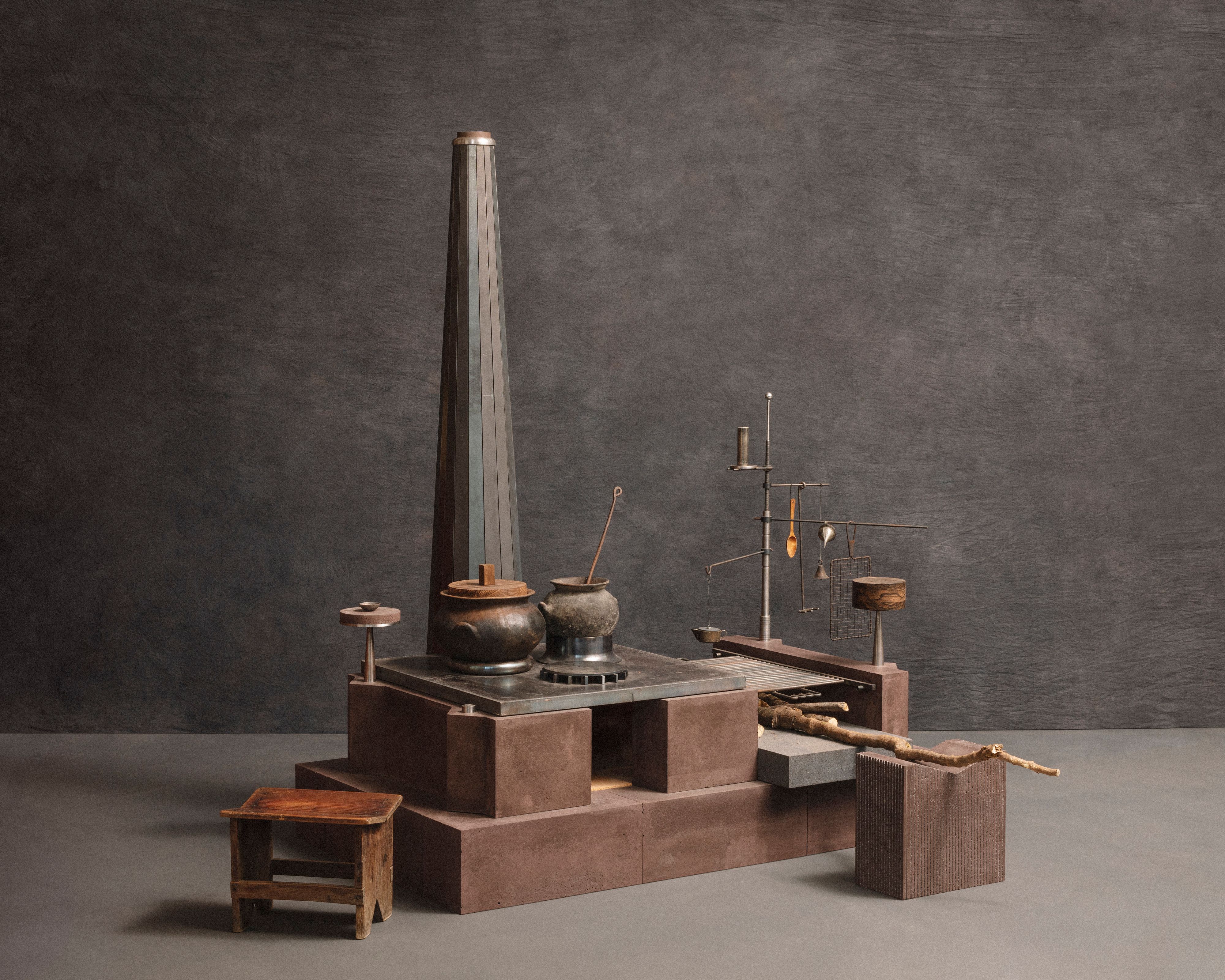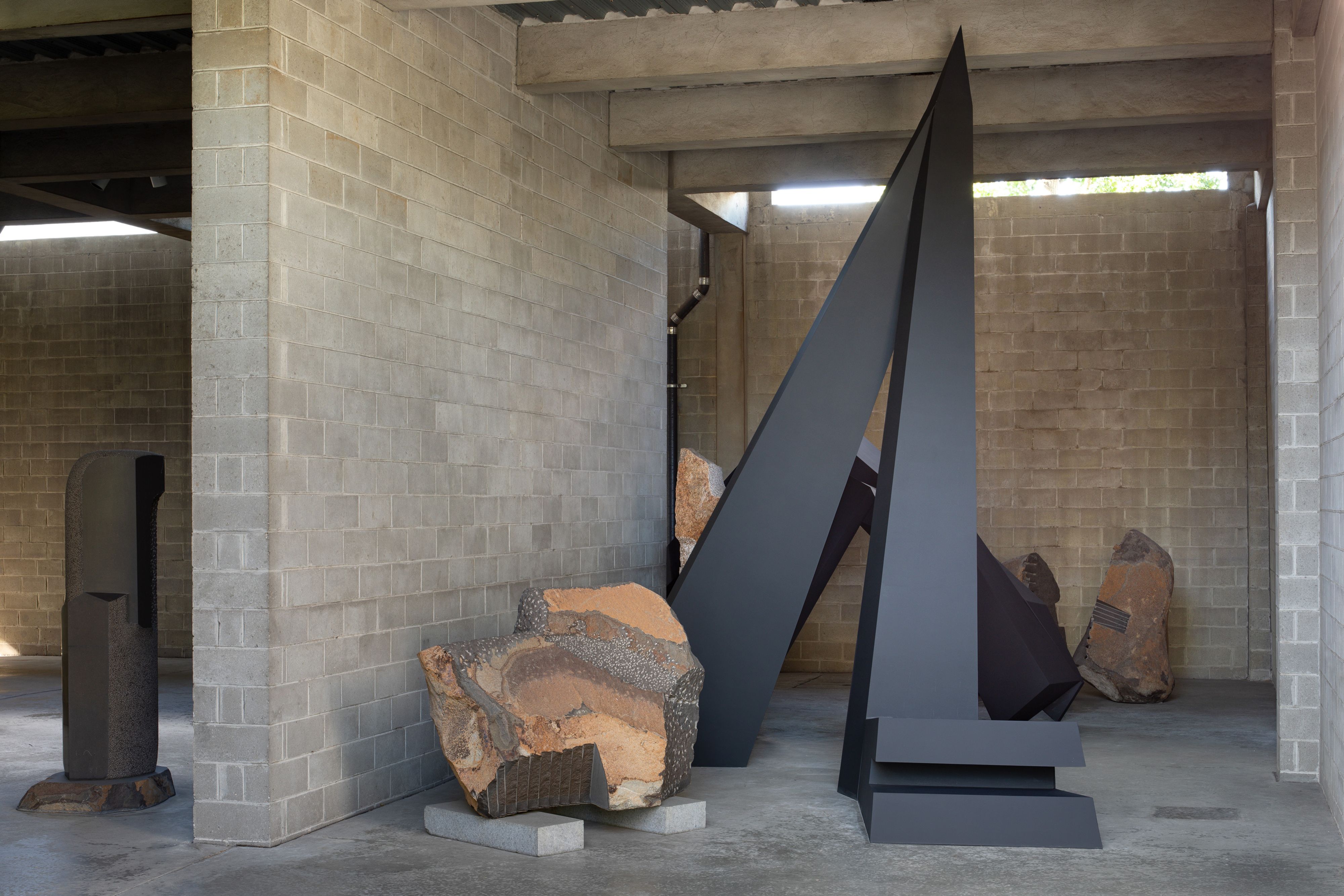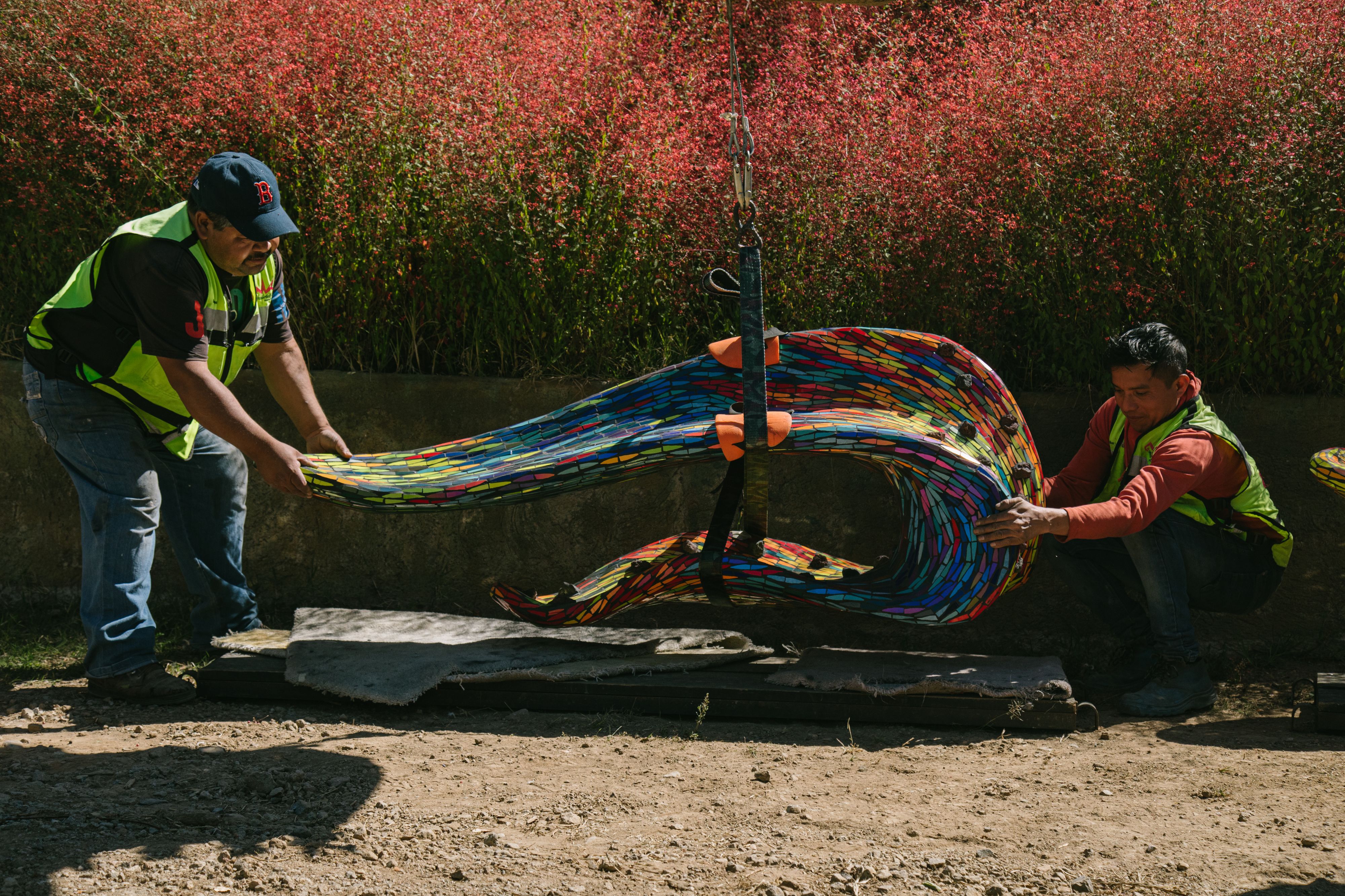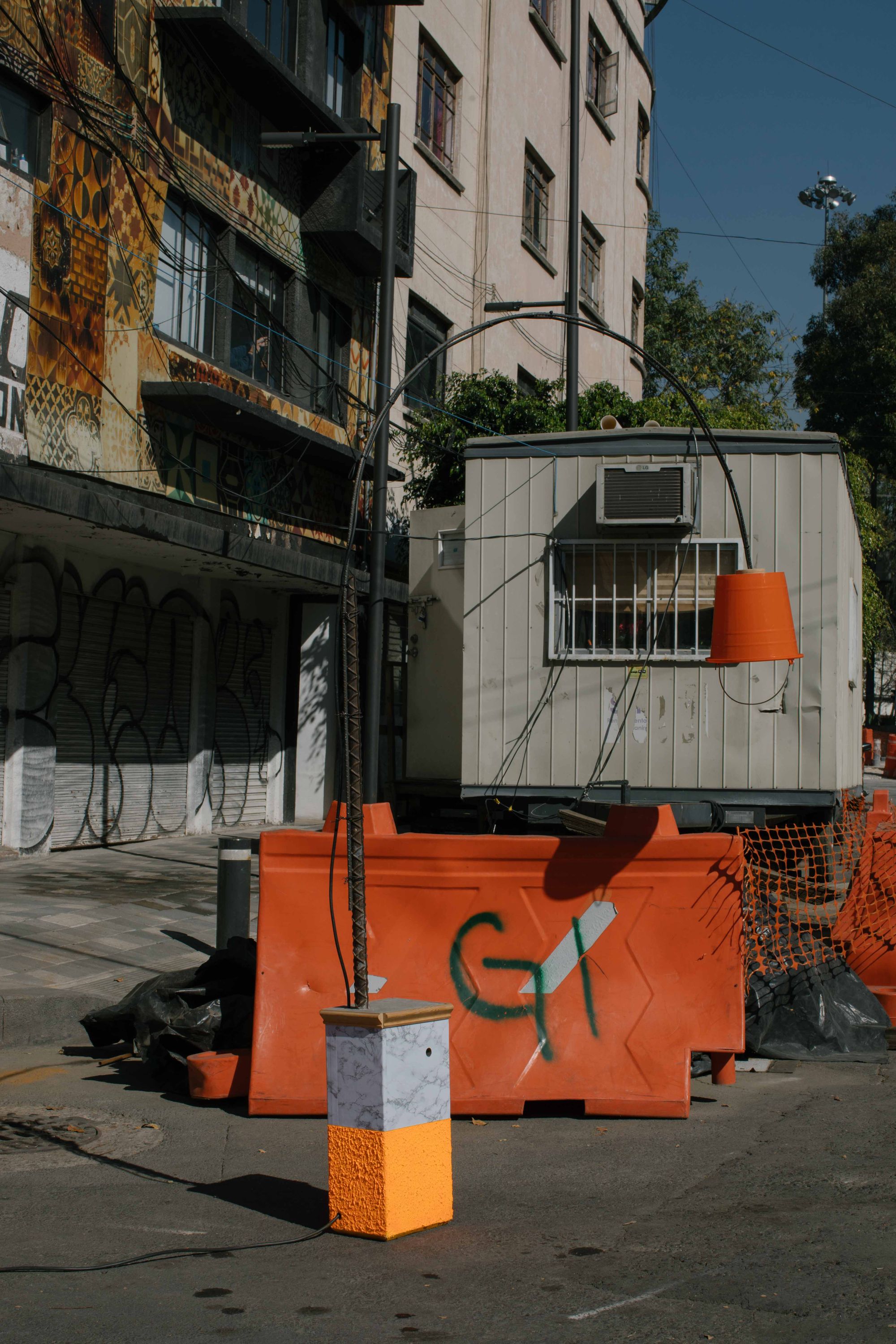
Mathias Goeritz, Hombre asustado (Startled Man), 1955. Wood. Private collection. Photo by Nicholas Knight.

Tezontle, Vernacular Kitchen, 2022; Copper, volcanic rock, concrete. Photography by Lucas Cantu. Courtesy of Friedman Benda and Tezontle.
In his 1977 The Prodigious Builders: Notes Toward a Natural History of Architecture, organicist and social historian Bernard Rudofsky promoted a new understanding of nature-adjacent living, broadening Western architectural practices and its canonized hierarchy. He writes: “Without doubt, the fact that most caves are gratuitously supplied by nature puts them beneath contempt. Snug and delightfully solid as most of them are... they are not offered for rent or for sale, and the idea of inhabiting one never occurs to us.” Bitingly, he contends that we’ve come to understand caves as being for “cavemen only,” where “troglodytism — living in caves — amounts to disowning one’s status as a human being.” He was expanding on the unified vision of nature, human life, and the built environment that Frank Lloyd Wright set forth with the Organic Architecture Movement decades prior, bringing caves, earthen forms and terrestrial materials into modern life. Organic Architecture bears relevance to contemporary bio-architecture and design practices, which seek to reorient the artifice we’ve come to depend on and, in turn, reawaken a newfound kinship with the Earth.

A full-scale replica of Mathias Goeritz’s La Serpiente de El Eco (El Eco Serpent), 1953 (exhibition copy fabricated 2022), in Isamu Noguchi’s indoor-outdoor sculpture garden. Daniel Goeritz Rodríguez, © Mathias Goeritz. Photo by Nicholas Knight.
Rudofsky’s text, sardonic as it may read, strikes a sobering chord in 2023. Increasingly, we’re confronted with the worsening status of our planet’s conditions, lack of feasible domestic development, and the need to shift our modes of living towards a greater network of interdependency with one another, as well as with nature. And now, this turn to the subterranean — framed vis-à-vis Rudofksy’s proposition — is being explored in the Noguchi Museum exhibition In Praise of Caves: Organic Architecture Projects from Mexico by Carlos Lazo, Mathias Goeritz, Juan O’Gorman, and Javier Senosiain. The multi-gallery show spans some of Mexico’s greatest champions of Organic Architecture, showcasing a synchronistic set of Earth-centric architectural plans, urban planning projects, and sculptures that are both utopian as they are achievable, as evidenced by many of their real-life renderings.

Mathias Goeritz, Untitled works from the series Open Mind and Empty Head, 1950. Gourd. Private collection. Photo by Nicholas Knight.

Mathias Goeritz, Hombre asustado (Startled Man), 1955. Wood. Private collection. Photo by Nicholas Knight.

Documentary model of the O’Gorman Cave-Studio House, 162 Avenue San Jerónimo (1948–54, partially destroyed c. 1969), 2021–22. Stone, acrylic, styrene. Created by Senosiain Arquitectos; Coordinator: Enrique Cabrera Espinosa de los Monteros; Collaborators: Marilú Martínez Tepecila, Angélica Ortiz Guerrero, María Fernanda Zarate Espinosa. Courtesy Javier Senosiain. Photo by Nicholas Knight.
Javier Senosiain, a former student of Goeritz at Universidad Nacional Autónoma de México (UNAM), is perhaps the most recognizable name of the group. His otherworldly park in Naucalpan, El Nido de Quetzalcóatl, is bookable on Airbnb and has witnessed a barrage of Instagram-driven attention, serving as the thematic nucleus to the show. Though each architect-artist has work featured throughout, it’s Senosiain’s prismatically-mosaiced, staggering snake bench, coiled around the columns of the museum’s central ground floor, where visitors can sit facing outward to absorb — and converse with — the pieces in their enveloping, subterrestrial totality.
This element of immersion is what makes In Praise of Caves so exceptional: to varying degrees, Lazo, Goeritz, O’Gorman, and Senosiain, have actualized (and lived in) the nature-oriented, architectural worlds they have created; their works, transported to a foreign urban center, serve as case studies to a domestic design approach that might, in abstraction, feel inconceivable amongst New York’s cramped quarters.

O’Gorman Cave-Studio House, 162 Avenue San Jerónimo (1948–54, partially destroyed c. 1969), 2021–22. Stone, acrylic, styrene. Created by Senosiain Arquitectos; Courtesy Javier Senosiain. Photo by Nicholas Knight.

Javier Senosiain Aguilar and Enrique Cabrera Espinosa de los Monteros,
La Coata, 2022. Concrete, mosaic. Courtesy Javier Senosiain / Arquitectura Orgánica. Photo by Nicholas Knight.
Across the East River at Friedman Benda Gallery, an engagement with imaginative living spaces — alongside a contemporary Mexican design sensibility — is also coincidentally being taken up in the furniture group show Everything Here is Volcanic. The title of the show is pulled from a letter that Swiss architect Hannes Meyer wrote to his peer Hans Schmidt right after moving to Mexico – the second director of the Bauhaus Dessau relocated from Germany in 1939, and ended up staying for a decade – in which he explains the impossibility of translating a Eurocentric vision of “rational modernity” to Mexico.
“Mexico is sort of a parallel vision of contemporary life. [It’s] very different from life in a place like New York, but at the same time it’s the same. We’re living in the same contemporary context in a very different way,” guest curator, designer, and writer Mario Ballestros tells me, calling in from his home in San Miguel de Allende. “The contemporary in Mexico is sort of atemporal: there’s a confusion of past, present, and future,” he explains, adding that the show “is not about the potential or the promise of Mexican design or art or contemporary production, but to find a way to channel everything that’s really exciting and attractive about the scene in the last ten to fifteen years.”

Courtesy of Friedman Benda and Javier Senosiain. Photography by Manuel Zuñiga.
The exhibition, which Ballestros describes as an “ultra contemporary-survey of Mexican things: strange artifacts, fittings and furnishings that belong in a transitional space,” features domestic objects from artists, designers, and makers, most of which have been specifically commissioned for the show. These range from the BDSM-inspired, piteado-embroidered leather saddle Jinete Nocturno (night rider) (2022) by architect-artist Aldo Álvarez Tostado and the technicolor Vulcan (2022) seat by Javier Sanosiain, to Andrés Souto’s tongue-in-cheek cHaRcO (2022) floor lamp: a plaster, rebar, and plastic bucket “bootleg” of the deified Arco original by Achille and Pier Giacomo Castiglioni.
The spiritual life force of home furnishings, and the dialogue they engage with their natural and built environments, remains a constant question in Everything Here is Volcanic. How can we regenerate the alienated state of our made world to reflect a more organic, and ergonomic, sense of living?

jinete nocturno (night rider), 2022. Courtesy of Friedman Benda and Aldo Álverez Tostado. Photography by Juan Rodríguez.

cHaRcO Lamp, 2022. Courtesy of Friedman Benda and Andrés Souto. Photography by Sergio Lopez.
Borrowing from Hannes Meyers’s “Co-Op Interieur” room, a revolutionary design theory of open-concept planning in small quarters, Ballestros has created a space that challenges the hyper-privatization of domestic living, seeking to relieve some of the aesthetic burden of modern life. “I’ve always loved that funky co-op, minimal dwelling, [that] radical idea of what a living space can be,” Ballestros says. “There was also that element of traditional vernacular houses in ancient Mexico, like in the Yucatan Mayan houses. It’s a single room and at that heart of it is the kitchen or the fire. The show is laid out [with] this idea of the ritual, the dream, and the encounter, [and] thinking about how we can change a living program.”
In Praise of Caves and Everything Here is Volcanic, both on display until the end of this month, offer crucial perspectives on the artifice of our current moment. For all its creature comforts, we are often reminded that we live in a world that can feel increasingly uncomfortable to simply exist in. For the mere moments we experience them in, then, these shows challenge us with the viability of alternative — and ultimately, far more livable — forms of organic connection to the spaces we call home.